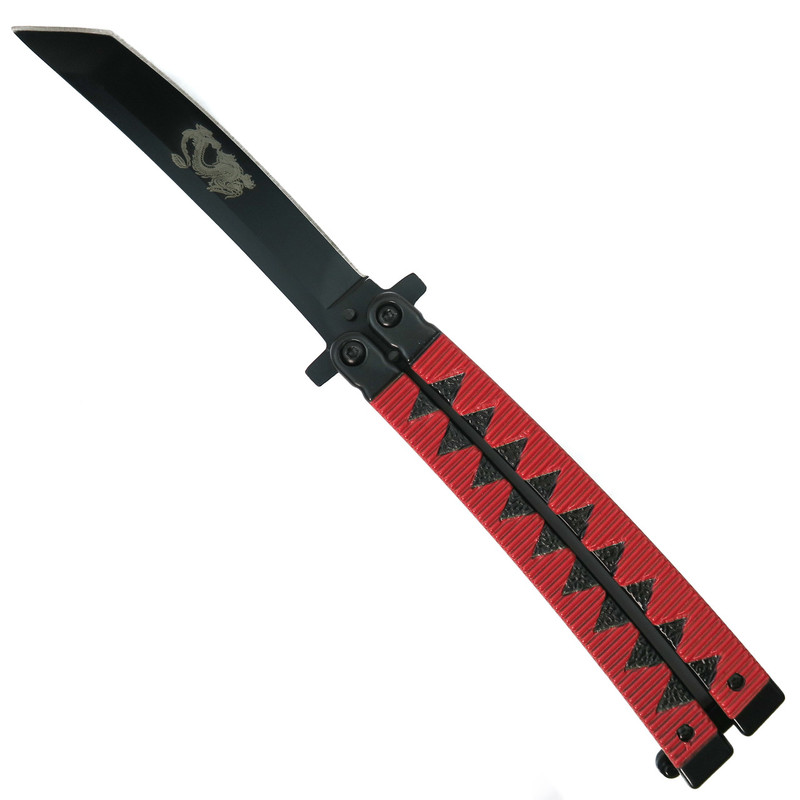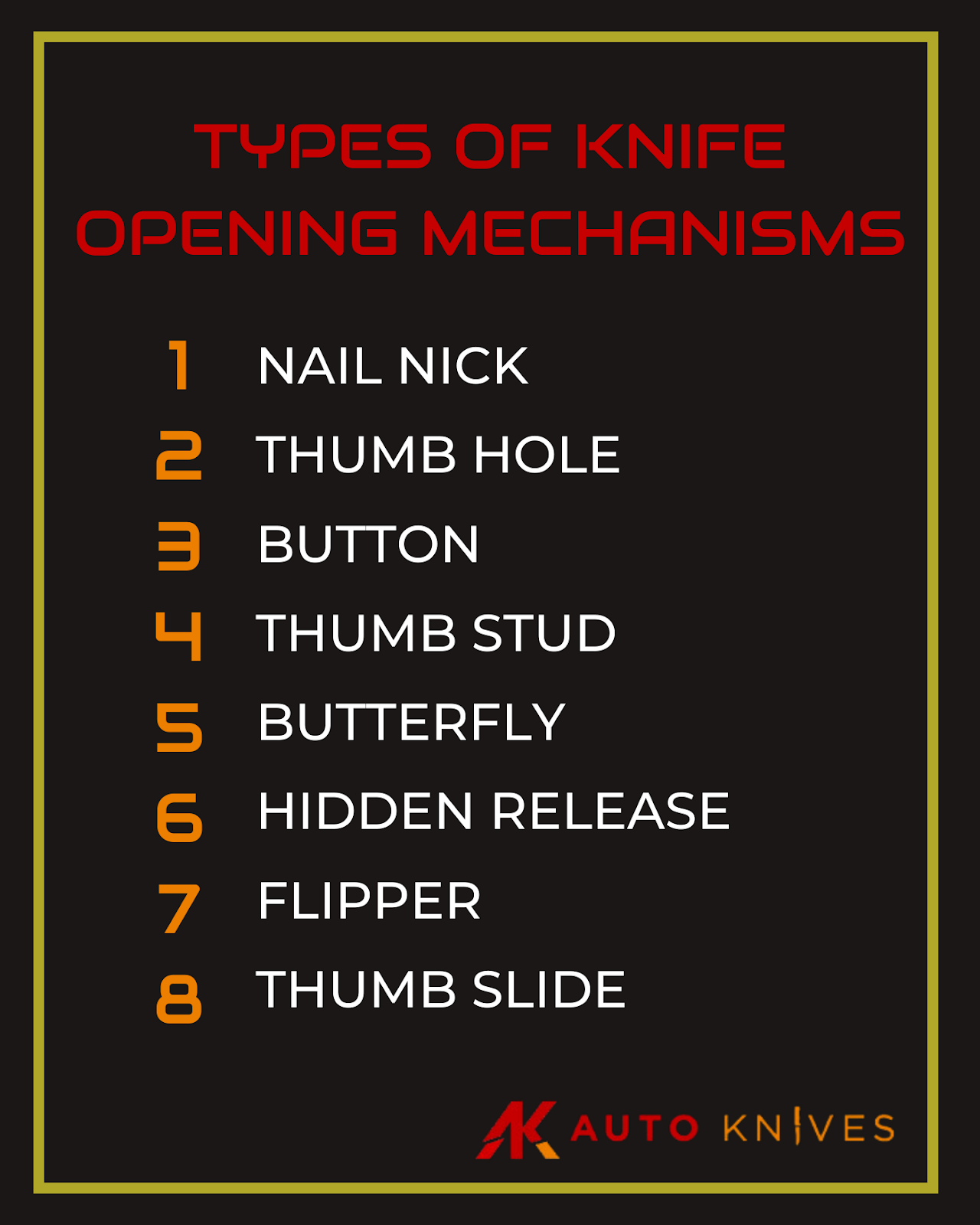Pocket knives are an important part of American life, whether you spend your time opening cardboard boxes, filleting fish, dressing game, or cutting wood. Many times we focus more on locking mechanisms and blade styles, but let’s take a closer look at opening mechanisms for your pocket knife, whether it’s your EDC (Every Day Carry) blade or something you have laying around for various cutting chores at home or on the job site.
Nail Nick
At one time the most basic opening feature for a pocket knife was the simple nail nick. This is a small groove or lip machined into the blade near the front and close to the top of the blade so that the knife can be opened using the edge of a fingernail. This style of opening is still used on slip joint knives, Swiss Army Knives, Barlow knives, and lock back knives like the Buck 110.
An advantage of the nail nick is that it makes for a safe method of opening for a young person because it typically requires the use of two hands to open or close the knife. Disadvantages to the nail nick would be slower or inconsistent opening when tried with one hand.
Thumb Hole
The round thumb hole opening mechanism was an ingenious design by Sal Glesser, the founder of Spyderco. It is an evolution of the nail nick but the size of the hole and the location guarantees a faster and more positive method of opening the blade. Spyderco not only patented the design but later used it as a trademark as it is one of several features common to Spyderco Knives that gives their knives a distinct look and feel.
Spyderco used to license the thumb hole out to other manufacturers and custom knife makers in exchange for a small royalty. However, many other manufacturers changed the shape of the perfectly round circle to an oval, hexagon or other shape to circumvent this process.
Button
Some knives such as switchblades or button lock folders open and close by means of a button. This rather novel method was invented in the early 20th century as a convenience for women with long fingernails to more easily open a folding knife without breaking a nail or ruining their manicures. Simply push a button and the knife opens quickly and easily.
Button locks fall into two categories. Those with springs and those without. A button lock folder opens manually and locks in both the open and closed positions with the button. A button lock automatic, sometimes referred to as a switchblade, opens with a spring. When you press the locking button, the blade fires open automatically and locks open with the button lock. To close it, you press the button and then manually close the blade. The blade then locks into the closed position with the button.
The disadvantage of this opening method is, in the 1950s and 1960s, lawmakers fell victim to a moral panic where automatic knives were portrayed in a negative light in movies, embellished news stories, and plays. As a result, these knives were outlawed in many jurisdictions. Although in recent years, many of these laws are being repealed.
Thumb Stud
A thumb stud or thumb disc is a device fitted to the blade of a folding knife that allows the user to push the blade outward in order to open it. Rather than have a recess milled into the blade like a nail nick or thumb hole, the thumb stud or disc projects outward and gives the user leverage to open the blade. In some cases, the thumb stud facilitates an assisted opening mechanism where the user starts pushing outward and internal torsion bars propel the blade into the open position. The thumb stud is typically mounted on the sides of the blade and the disc mounts to the top.
Thumb studs are common on blades from SOG, Bear & Son, or Benchmade whereas companies such as Emerson Knives most often rely on the thumb disc.
Butterfly
The butterfly knife, also known as the balisong, is a knife that comes to us from the Philippines. The handle is a two-part affair that encompasses the blade when it is closed. To open the knife, the user flips one section of the handle down, rotates it halfway, and flips the handle back to the hand. Some models employ a latch at the base of the handles to keep it as strong as a fixed blade and prevent it from opening.
Hidden Release
The Hidden Release is a type of automatic knife where the opening button is not readily apparent to whoever picks the knife up. In some cases, it may be moving the bolster slightly downward. More advanced custom designs may have small tumblers that need to be lined up in a certain manner in order to deploy the blade.
A downside here can be an additional level of complexity required to open or close the blade.
Flipper
A flipper is a method of opening where the user may use their thumb or index finger to press down on flipper tab which protrudes from the back of the blade. Bearings or some other method usually propel the blade to the open position where it locks up.
The only real downside to certain flippers is when no bearings are used and the manufacturer intends the user to open it by flicking their wrist to open the knife. This seems to defeat the purpose of a flipper in most people’s eyes.
Flippers used to be solely in the realm of custom makers but factory knives by Kershaw, CRKT, Spyderco, WE, and other manufacturers have been rolling them out over the past two decades.
Thumb Slide
The thumb slide is like a manual or assisted opening take on an out the front (OTF) automatic knife. Rather than pressing or pushing a button that propels the knife forward, the thumb slide allows the user to manually push the blade open. You may have seen this on Stanley utility knives or razor knives floating around job sites, but manufacturers such as Kershaw, Schrade and Smith & Wesson make use of this style as well.
One of these blades may be the best way to carry an OTF that is not a switchblade. They reduce the risk of lock failure in that if the lock fails, the knife simply retracts back into the handle as opposed to closing on the user’s fingers.
Which Should You Choose?
The type of opening method you choose is largely a matter of personal preference. Although some tasks may dictate a particular method a much as a blade shape or locking mechanism might.
In certain instances, local laws may be a factor. Despite the United States constitution guaranteeing the right to keep and bear arms, switchblade knives, gravity knives or butterfly knives may be prohibited. Other cities and states may prohibit carrying of a knife based on blade length These laws vary as some jurisdictions allow people to own the and keep these restricted knives in their homes, but restrict them from being carried. It is your responsibility to check all local laws wherever you plan to carry a knife.
Rather than ask a law enforcement officer, the best advice is to consult the State’s or City’s Attorney General’s office. These statutes are often listed on a public website. In certain instances, it may not be a bad idea to have a printed copy of these laws on hand, particularly if the laws may border on being a felony. It is hard to believe that an opening mechanism could determine a knife’s legality but it is something most knife owners have to deal with in certain areas.
For EDC, the one-handed opening knives tend to be the most popular. These are your assisted openers, thumb studs, flippers, automatic knives or those with a thumb hole. Certain tasks like self-defense require deploying the knife quickly. This is often more of a factor than anything else. However, this can also come into play in a rescue situation where you need quick access to a blade. A good pocket clip to keep the knife in position is recommended, too.
Hunting tasks are best performed with a fixed blade, but a proper liner lock or a strong lock back knife with a drop point or clip point blade can accomplish the same tasks.
If you are collecting: All of these knives can be collected, regardless of opening mechanism, unless the mechanism is particularly unique or specific to the goals of the collection. For example, a collection of Swiss Army Knives might be made up exclusively of knives that open via nail nick, whereas a Spyderco collection would consist predominantly of knives that open with a thumb hole.
Shop Auto Knives For Your Next Knife Purchase
AutoKnives.com carries one of the largest inventories of production knives in the US for EDC, survival, hunting, self-defense or simply collecting different varieties. Whether you want blades of stainless steel, carbon steel, liner locks, switch blades or fixed blades; chances are that Auto Knives has the next blade that you are looking for.


